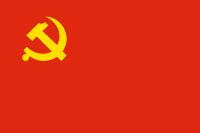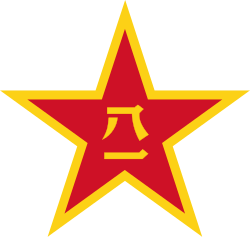People's Liberation Army militia
| People's Liberation Army Militia 解放军民兵 | |
|---|---|
|
Flag of the Communist party of China used by militia | |
| Active | 1927 – present |
| Country |
|
| Allegiance | Communist Party of China[1] |
| Branch | People's Liberation Army |
| Type | Militia |
| Size | 3 million |
| Engagements |
Chinese civil war Korean war Sino-Vietnamese War |
The People's Liberation Army Militia (PLAM) (simplified Chinese: 解放军民兵; traditional Chinese: 解放軍民兵; pinyin: Jiěfàngjūn mínbīng) is the Militia of the Communist Party of China and it is one of the largest party militia in the world. The PLAM can trace its lineage from 1927. As of 2016, the PLAM has a strength of 3,000,000 personnel.
History
The role of the militia has varied over the years. During the 1940s the militia served as a support force for PLA. After 1949 the party consolidated control over the country and used the militia to maintain Law and order in the country and for defense of the borders and coast. In the mid-1950s, Peng Dehuai attempted to build the militia as a reserve force. However, his efforts were thwarted, when the party expanded the militia, assigning it duties as a internal security force during the Great Leap Forward. Lin Biao reduced the size of the militia and reemphasized military training in the early 1960s. The militia was fragmented during the early years of the Cultural Revolution, but in the 1970s it was rebuilt to support the PLA. The Gang of Four also attempted to build up the urban militia as an alternative to the PLA, but the urban militia failed to support the Gang of Four, when Hua Guofeng and other moderate military leaders deposed them. The militia's logistical support of the PLA was essential during the Sino-Vietnamese War. In the 1980s, Chinese leaders improved the militia's capabilities by reducing its size and economic works.
References
Citations
- ↑ "The PLA Oath" (PDF). February 2009. Retrieved October 30, 2015.
I am a member of the People's Liberation Army. I promise that I will follow the leadership of the Communist Party of China...
Sources
- Military Balance 2006, International Institute for Strategic Studies
- Sinodefence.com – Chinese military information website
- http://www.globalsecurity.org/military/world/china/pla-militia.htm
-
 This article incorporates public domain material from the Library of Congress Country Studies website http://lcweb2.loc.gov/frd/cs/.
This article incorporates public domain material from the Library of Congress Country Studies website http://lcweb2.loc.gov/frd/cs/.

